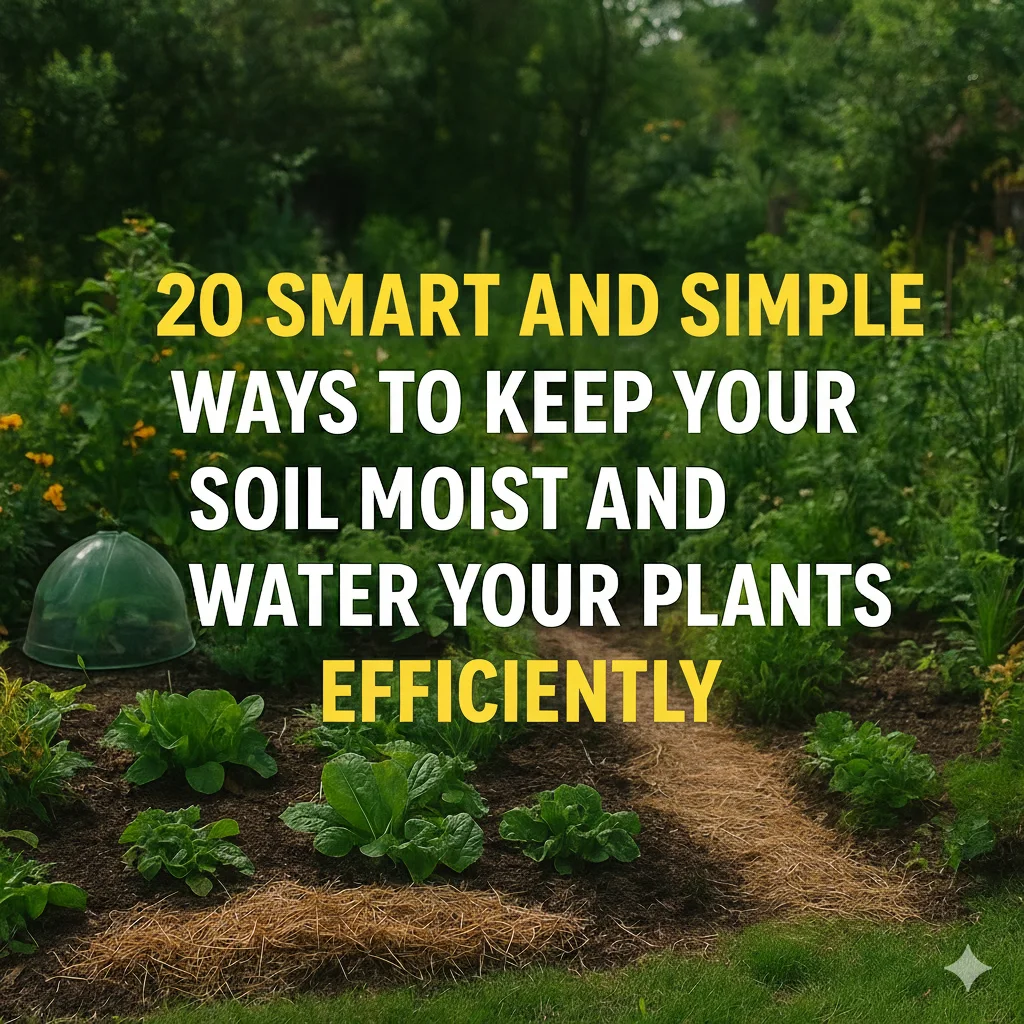Keeping your garden soil consistently moist can feel like a full-time job, especially during hot or dry seasons. But with a few smart strategies, you can save water, reduce effort, and help your plants thrive. From simple watering techniques to clever DIY solutions, there are plenty of ways to make sure your soil stays hydrated without overcomplicating your gardening routine.
5 Smart and Simple Ways to Keep Your Soil Moist and Water Your Plants Efficiently
1. Use Mulch to Lock in Moisture
Covering your soil with mulch is one of the easiest ways to retain moisture. It acts like a blanket, preventing water from evaporating too quickly. Organic options like shredded leaves, straw, or bark also improve soil fertility as they break down. A practical tip: apply a 2–3 inch layer around your plants, but keep it slightly away from the stems to avoid rot. I always find that my tomato plants thrive much better when I add mulch early in the season.
2. Water Early in the Morning
Watering your plants in the morning helps reduce evaporation, allowing the water to soak deep into the soil. It also gives the foliage time to dry before nightfall, reducing the risk of fungal diseases. I’ve noticed that my garden looks much fresher all day long when I stick to morning watering instead of evening routines.
3. Install a Drip Irrigation System
Drip irrigation delivers water directly to the roots where it’s needed most, cutting down on waste. It’s perfect for both small and large gardens. A simple DIY tip: you can even repurpose old hoses with small holes to create a budget-friendly version. Once I set this up, I spent less time dragging hoses around and my plants were noticeably healthier.
4. Group Plants with Similar Water Needs
Organizing your garden so that plants with similar watering requirements are together makes it easier to water efficiently. This way, you won’t overwater some plants while underwatering others. I learned this the hard way when my herbs were drowning while my succulents were still thirsty! Now, I always group by water needs and the garden feels much more balanced.
5. Use Self-Watering Containers
For potted plants, self-watering containers are a game-changer. They provide a reservoir that allows the soil to draw water as needed, reducing frequent watering. A practical touch: I keep these on my balcony, and it’s amazing how they maintain soil moisture even during hot days when I’m out of town.
6. Add Compost to Improve Water Retention
Mixing compost into your soil not only nourishes your plants but also helps the soil hold moisture longer. Compost acts like a sponge, absorbing water and releasing it slowly to the roots. I always sprinkle a layer of compost around my flower beds in spring, and it’s amazing how much less I need to water afterward.
7. Use Water-Retaining Crystals or Gels
These little crystals might seem unusual, but they can store water and release it gradually into the soil. They’re especially useful in potted plants or sandy soils that drain quickly. A tip from experience: just mix a small amount into the potting mix—too much can make the soil overly dense.
8. Create Shade for Sensitive Plants
Some plants lose moisture too quickly in direct sun. Providing temporary shade, like a garden cloth or strategically placed taller plants, can help reduce evaporation. I use shade cloth for my young seedlings during hot afternoons, and it’s saved me from losing more than a few precious plants.
9. Water Deeply, Not Frequently
Shallow, frequent watering encourages roots to stay near the surface, making plants less drought-resistant. Deep watering once or twice a week encourages roots to grow deeper, accessing more moisture naturally. I try to water my garden slowly with a hose for 10–15 minutes per area, and the plants always look stronger and more resilient.
10. Collect and Reuse Rainwater
Rainwater is free, chemical-free, and perfect for watering plants. Setting up a simple barrel to collect runoff from your roof can save a lot of water. I keep a couple of barrels in my backyard, and it’s satisfying to know my garden is thriving on natural rainwater rather than tap water.
11. Use Thick, Moisture-Retentive Soil
Choosing or amending your soil with materials that hold water well, like loam mixed with organic matter, helps keep moisture available longer. I once switched my vegetable beds to a richer mix, and the difference was noticeable—plants stayed hydrated even during a week of hot weather.
12. Water at the Base, Not the Leaves
Directing water to the roots instead of spraying leaves ensures the plant actually gets what it needs and reduces evaporation. I use a small watering can or a gentle hose attachment, and it’s amazing how much water I save while keeping the foliage healthy.
13. Layer with Straw or Grass Clippings
If you don’t have bark mulch, straw or even fresh grass clippings can help retain soil moisture. Just make sure the clippings aren’t too thick or they may mat down and block air. I often use clippings from my lawn—they’re free, effective, and give my garden beds a nice fresh look.
14. Create Mini Swales or Contours
Shaping your garden beds so water naturally collects near plants can make a big difference, especially in sloped areas. Even small depressions around plants act like reservoirs. I tried this on a small hill in my garden, and now water stays longer after rain, keeping my plants happier.
15. Rotate Watering Spots
If you have a large garden, rotate where you water each day instead of hitting the same area repeatedly. This prevents soil from becoming compacted and encourages even moisture distribution. I noticed my garden looks healthier when I alternate watering spots rather than soaking the same area every time.
16. Use Porous Pots for Better Moisture Control
Clay or terracotta pots allow excess water to evaporate slowly, helping maintain consistent soil moisture. I switched a few of my potted herbs to terracotta, and they seem to thrive without the risk of overwatering.
17. Layer Soil with Pebbles or Rocks
Adding a layer of small rocks or pebbles at the bottom of pots improves drainage while reducing water loss from the surface. I like to do this for my indoor plants—it prevents soggy roots while keeping the soil evenly moist.
18. Cover Soil with Newspaper or Cardboard
Old newspaper or cardboard can act as a temporary mulch, blocking sunlight and slowing evaporation. I sometimes use this trick for seedlings—it’s cheap, effective, and decomposes naturally into the soil.
19. Use Wicking Systems for Containers
A wicking system draws water from a reservoir below the soil, keeping potted plants hydrated steadily. I built a simple DIY version with a cloth strip, and it’s perfect for keeping my balcony plants alive during busy weeks.
20. Group Pots Together to Retain Humidity
Placing potted plants close to each other creates a mini microclimate, reducing evaporation and keeping soil moist longer. I’ve noticed that my balcony garden stays greener when pots are clustered instead of scattered individually.
Maintaining moist, healthy soil doesn’t have to be a challenge. By using methods like mulching, deep watering, rainwater collection, and smart container choices, you can keep your plants happy and reduce water waste. A little planning and these practical tips go a long way toward a flourishing, low-maintenance garden that stays vibrant all season long.


